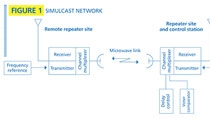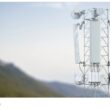Designing simulcast networks
Simulcast is an abbreviation for simultaneous broadcast, and in the context of land mobile radio, it means simultaneous transmission from two or more repeater sites on the same radio frequency and with the same modulation. Simulcast has been around since the 1960s, but its popularity has increased recently — in part because modern technology has made simulcast more reliable.
Simulcast networks offer several advantages:
- Overlapping coverage without handoff complexity.
- Better trunking efficiency.
- Simpler operation, especially for conventional (non-trunked) repeater systems.
Simulcast networks also employ voting receivers, which offer macro-diversity improvement on the inbound path.
Disadvantages of simulcast include high cost and signal distortion in simulcast-overlap regions. High cost results from more complex timing and control hardware, but also from the simple fact that each site must be populated with one repeater for each frequency used in the network. In contrast, a multisite system incorporates a handoff algorithm that chooses the site with the best signal. With multisite, the number of repeaters at each site is driven by traffic engineering considerations to ensure a low blocking probability.
Signal distortion in simulcast overlap regions also is referred to as time delay interference. TDI occurs when two or more simulcast signals arrive at the user’s radio antenna with comparable amplitude and relatively large delay. Note that both conditions must occur for TDI to be a problem. If one site dominates, the carrier-to-interference ratio (C/I) is sufficient to overcome the delayed signal no matter how long the delay. Conversely, if the two signal amplitudes are comparable and the C/I is low, short delays are still tolerable. Two simultaneous signals with short delays appear to the receiver as one signal and no noticeable distortion occurs. In fact, if the two signals are of equal amplitude, the receiver sees a signal that is 3 dB stronger than it would appear otherwise.
When to use simulcast
Because simulcast systems are pricey, the vendor may propose simulcast even when conditions don’t warrant it. The “better coverage” advantage often is oversold. True, seamless overlapping coverage is an advantage of simulcast, but multisite systems also have seamless overlapping coverage, provided an effective handoff algorithm is used. To control TDI in simulcast networks, it often is necessary to use directional antennas so only one site dominates in regions of long delays. Each repeater site is a major investment. If a 90°-beamwidth antenna is required to control TDI, then the site is providing only one-quarter of its potential coverage, but the cost is identical to the cost of an omnidirectional site.
The most compelling reason for choosing simulcast then is not coverage improvement, but lack of frequencies. When frequencies are in short supply, simulcast is the right solution.
Elements of a simulcast network
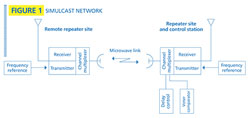
The essential elements of a simulcast network are the repeater sites (two or more), repeaters, antennas, multiplexer, voter comparator, accurate frequency reference, and interconnecting network. A block diagram of a simulcast network is shown in Figure 1.
The simulcast multiplexer performs an important function that is not obvious from its name: It introduces the relative baseband (audio) delay between sites to control TDI. Control of baseband delay and receiver voting are functions that occur in the control station, which often is co-located with one of the repeater sites. The interconnecting network usually employs T-1s, riding either landlines or microwave links. Public-safety agencies tend to favor a dedicated microwave network for reliability reasons and to preclude unwanted delays when landlines are rerouted by the telephone company. However, modern simulcast multiplexers measure actual delay and adjust timing dynamically, making landlines more attractive than in the past.
Early simulcast systems employed transmitters with custom-cut and matched crystal oscillators to ensure each transmitter was operating on precisely the same frequency. This approach was imperfect and repeated tuning was required as each crystal aged in order to keep the frequencies within specification. Later, expensive rubidium atomic clocks were used, but the modern approach is to employ specialized GPS receivers at each repeater site to train the transmitter’s oscillator.
TDI
Probably the most important question for the network designer is: How much TDI is too much? The answer depends on the particular modulation technique used and whether the system is analog FM or digital. Analog FM systems on 25 kHz channels typically can withstand two relatively strong, equal amplitude signals with up to 150 microseconds relative delay before speech is unintelligible, according to Garry C. Hess in Land-Mobile Radio System Engineering. Vendors of digital radio systems and analog trunked systems with control channels generally specify maximum TDI in terms of a combination of the number of overlapping signals, delay and C/I (sometimes called the “capture” ratio).
For example, the vendor of a trunked system with a 9600 bps binary FSK control channel might specify that the TDI can be no more than 32 microseconds (31% of a symbol period) in regions where the C/I is less than 12 dB, as long as there are just two overlapping signals. The delay requirement might be more stringent if there are three or more significant overlapping signals. An alternative approach is to specify a maximum root mean square (rms) delay spread, which is a weighted combination of multiple overlapping signals that takes into account the delay and amplitude of each signal.
Design approaches
When designing a simulcast network, the designer first uses computer propagation models or drive-test measurements to predict the coverage from each candidate site. Larger networks rarely are feasible if all repeater sites employ omnidirectional transmit antennas because harmful TDI is created in overlap regions, regardless of the particular time delays used. In this case, directional antennas are needed to control TDI. The number of possible combinations of delays and antenna patterns can be in the thousands, and even modern computers cannot model all possible combinations in the designer’s lifetime. Consequently, the designer may resort to rules of thumb.
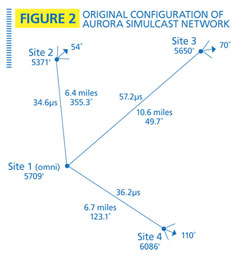
One common rule of thumb is to employ an omnidirectional antenna at a single central site and employ directional antennas at the surrounding sites pointing away from the central site. Doing so makes control of TDI easier and more predictable. However, once the antenna patterns are chosen, other more effective combinations may not be considered. Often, it is feasible for two or more sites to employ omnidirectional antennas without causing harmful TDI in the service area, but this case may be overlooked because the rule of thumb was applied too soon.
Now let’s consider a real-world simulcast system where the owner started out with just one omnidirectional site, but later found that a second site could also employ omnidirectional antennas with much improved coverage and without harmful TDI.
The City of Aurora, Colo., operates a 20-channel, 800 MHz, four-site simulcast network. The designer designated one of the sites omnidirectional, and after a trial-and-error process in which multiple combinations of antenna pattern and delay were simulated using a computer model, he settled on the network configuration shown in Figure 2.
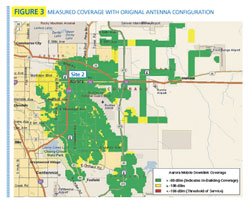
After the network was installed, some users complained of poor service west of Site 2. Because Site 2 employed a directional antenna pointing toward the northeast, an omnidirectional site (Site 1) served the area to the west. My firm was asked to consider potential improvements to the network, and the firm worked jointly with the vendor to test and implement viable solutions.
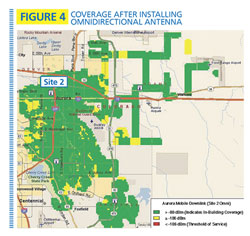
To accurately assess the radio coverage, we conducted drive-test measurements of the existing network, but we also measured signals from test transmitters with omnidirectional antennas temporarily installed at the three directional sites. In this way, we could assess both the existing coverage and the theoretical (but not necessarily achievable) best-case coverage using omnidirectional antennas at each site. Once the measurements were collected, we used computer software to apply directional antenna patterns to the measurements, testing many combinations of antenna pattern and delay.


